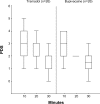Efficacy of tramadol as a preincisional infiltration anesthetic in children undergoing inguinal hernia repair: a prospective randomized study
- PMID: 25285011
- PMCID: PMC4181647
- DOI: 10.2147/TCRM.S62029
Efficacy of tramadol as a preincisional infiltration anesthetic in children undergoing inguinal hernia repair: a prospective randomized study
Abstract
Background: Preincisional local anesthetic infiltration at the surgical site is a therapeutic option for postoperative pain relief for pediatric inguinal hernia. Additionally, tramadol has been used as an analgesic for postoperative pain in children. Recently, the local anesthetic effects of tramadol have been reported. The aim of this study was to determine both the systemic analgesic and the local anesthetic effects of tramadol and to determine how it differs from bupivacaine when administered preincisionally.
Methods: Fifty-two healthy children, aged 2-7 years, who were scheduled for elective herniorrhaphy were randomly allocated to receive either preincisional infiltration at the surgical site with 2 mg/kg tramadol (Group T, n=26) or 0.25 mL/kg 0.5% bupivacaine (Group B, n=26). At the time of anesthetic administration, perioperative hemodynamic parameters were recorded. The pain assessments were performed 10 minutes after the end of anesthesia and during the first 6-hour period, using pain scores. The time of first dose of analgesia and need for additional analgesia were recorded.
Results: Between T and B groups, the anesthesia time, perioperative hemodynamic changes, and pain scores were not statistically different. However, in group B, the postoperative analgesic requirement was higher than in group T.
Conclusion: Tramadol shows equal analgesic effect to bupivacaine and decreases additional analgesic requirement, when used for preincisional infiltration anesthesia in children undergoing inguinal herniorrhaphy.
Keywords: bupivacaine; pain scores; postoperative analgesia.
Figures



References
-
- Dahl JB, Møiniche S. Pre-emptive analgesia. Br Med Bull. 2004;71:13–27. - PubMed
-
- Møiniche S, Kehlet H, Dahl JB. A qualitative and quantitative systematic review of preemptive analgesia for postoperative pain relief: the role of timing of analgesia. Anesthesiology. 2002;96(3):725–741. - PubMed
-
- Bay-Nielsen M, Klarskov B, Bech K, Andersen J, Kehlet H. Levobupivacaine vs bupivacaine as infiltration anaesthesia in inguinal herniorrhaphy. Br J Anaesth. 1999;82(2):280–282. - PubMed
-
- Bozkurt P. Use of tramadol in children. Paediatr Anaesth. 2005;15(12):1041–1047. - PubMed
-
- Pang WW, Mok MS, Chang DP, Yang TF, Lin CH, Huang MH. Intradermal injection of tramadol has local anesthetic effect: a comparison with lidocaine. Acta Anaesthesiol Sin. 1998;36(3):133–136. - PubMed
LinkOut - more resources
Full Text Sources
Other Literature Sources

